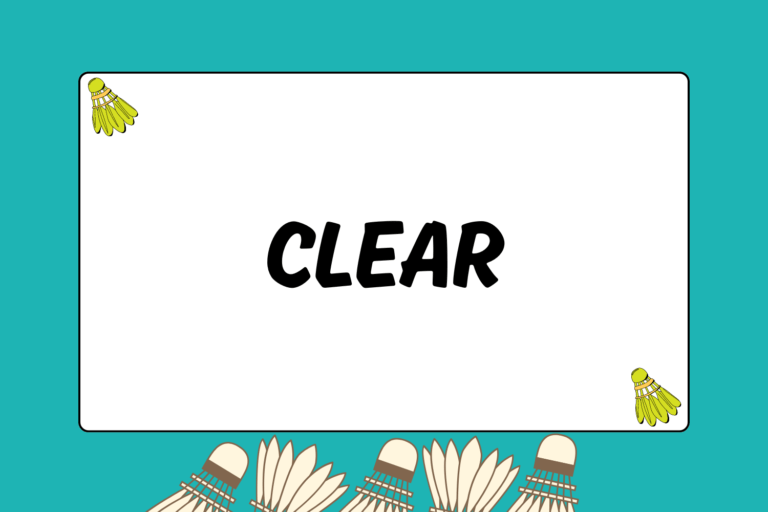There are essentially three basic grips used in badminton. These grips form the basis for all strokes and shots.
The forehand, backhand, and panhandle grip each have subtle variations, but this guide will only cover the main grips and their associated strokes. This will provide a foundation from which you can fiddle with as you gain more experience.
Forehand Grip
Often referred to as the “handshake” grip, the forehand grip is the first you should familiarize yourself with because it is used in many basic shots.
A quick way to get comfortable with this grip is to have someone extend the racket’s handle to you as though they were shaking hands. Make sure the racket head is perpendicular to the ground so that the top view of the racket forms a line.
Now, “shake” the handle of the racket like you would shake someone’s hand and adjust it slightly to where you feel most comfortable. Your thumb and pointer finger should make a ‘V’ shape on the handle.
Forehand Stroke
The key to doing a proper forehand stroke is simply following through with your swing.
What this means is that any forehand stroke taken from the forehand side should allow momentum to carry the racket to the backhand side with the arm crossing over the body. This will increase the power of your swing and promote consistency across all of your forehand shots.
Following through is essential because the forehand stroke is responsible for hitting clears, drops, and smashes with the greatest consistency and power.
Backhand Grip
The backhand grip in badminton is the hardest of the three grips to learn. This is because it’s the least natural grip and is compatible with the least natural stroke.
The grip itself is fairly straightforward, as it requires only a simple inspection of the racket handle to see how to grip it. If you look at the handle, you’ll see that its base is rectangular, making one side wider than the other.
Place your thumb flush against the wider side and wrap the remaining fingers around the handle. Here, the thumb will serve as the power and control for all your backhand shots. Holding the racket out in front of you should put your thumb in an upright position and allow you to point your thumb all the way toward the downward position.
Backhand Stroke
Proper technique for backhand shots is more important than in other strokes because of its sheer inefficiency.
Start off by standing near the baseline with your back parallel to the net. Point your elbow at roughly 45 degrees or steeper with your wrist cocked forward slightly.
Next, swing by snapping your elbow and wrist out while stepping toward the net with your dominant foot. The reason for stepping toward the net with your foot is to use the momentum from your body to help you generate power.
Aside from using a different set of muscles from the forehand, the backhand has a shorter follow-through, hampering your ability to generate power. Some of the power will come from the rotation of your body, but a bulk of it must now come from the wrist.
Remember to contact the shuttlecock at the highest possible point to make it easier. Do not be discouraged if the shuttlecock isn’t traveling very far at the start because the backhand shot is naturally a player’s weakest shot.
While advanced players can do a forehand clear using only their wrist, you’ll be hard-pressed to find anyone who can do the same with the backhand.
Panhandle Grip
The panhandle grip is named as such because of its likeness to holding the handle of a pan. This grip is used almost exclusively for drive shots because it allows you to hit in a wide range of motions while still generating the necessary quickness and power.
To learn this grip, start with the forehand grip and simply rotate the racket an eighth of the way outward, away from your body. If held correctly, the racket head should be parallel to the net when you hold the racket up with your wrist bent backward.
You should also be able to move the racket in a quick flicking motion using your wrist, much like the motion you’ll use for drive shots.
Panhandle Stroke
The stroke for the panhandle shouldn’t be anything more than the quick, flicking motion described above. The power comes from your palm and wrist driving the racket forward and should be used almost exclusively for drive shots.
Drives are quick shots that have a flat trajectory and should pass low over the net. You should be able to cover drive shots on both your forehand and backhand side using this stroke.
A large part of learning the panhandle stroke lies in knowing when not to use it. This is because a new player will sometimes substitute the panhandle stroke for his forehand stroke.
Doing this may seem more natural to some, but it essentially promotes less power and control. Holding the racket panhandle style and taking a full swing will also limit your motion and the variety of shots you can take.
Switching It Up
There’s no secret behind learning how to switch grips quickly. Unfortunately, that will only come with time and practice.
You need to become familiar enough with each grip to be able to switch seamlessly by just the feel of it. It’s a good idea to practice each grip and stroke individually before trying to incorporate all three at once.
The important thing is to focus on proper form and stroke, because switching between grips should come naturally from consistent practice.





